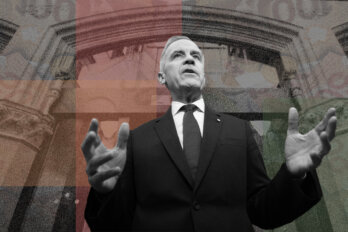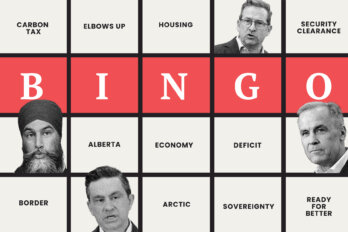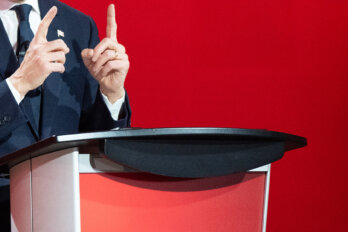For some Canadian parents of young children, there’s only one issue that matters this election: the future of the Canada-wide Early Learning and Child Care (CWELCC) plan, a policy that reduces daycare fees in some provinces to as little as $10 a day.
In one of his last executive moves, former prime minister Justin Trudeau announced a five-year extension of the program, which was first launched in 2021 with the support of Jagmeet Singh’s New Democratic Party. This time around, Trudeau promised to increase funding to provinces by 3 percent per year over a four-year period—money that would help daycares struggling with operational costs. Eleven provinces and territories signed on for the extension immediately. Alberta and Saskatchewan, to date, have not reached an agreement, despite protests from local child care providers and opposition critics.
“In the past few weeks, we have been working with our provincial and territorial partners to make sure that families can rely on this system,” Trudeau said in March, “to become something that no government, a year from now, five years from now, twenty years from now, could ever go back on.” Despite a number of growing pains, the program has proven exceptionally popular among Canadians. One Reddit user said that the program brought her child care fees down from $2,400 a month to $480.
But now, with a federal election underway, CWELCC’s future is unclear. Liberal leader Mark Carney’s platform touted the program’s benefits—and pledged to add 100,000 new spaces by 2031—but questions about how he would improve or expand it remain. Meanwhile, Conservative leader Pierre Poilievre has made confusing and sometimes contradictory statements about the plan. At one campaign stop in March, he said that he would eliminate Liberal bureaucracy, which he believes has decreased the number of child care spaces, but that he would also honour the agreements already made with the provinces.
There is a pattern in Canada where a federal child care program is planned by one government, only to be taken down by the next.
The 1970 report by the Royal Commission on the Status of Women in Canada is often cited as the first step in the country’s fifty-year road to a federal child care plan. The recommendation, which was the first in the report, set off a series of attempts to launch a national program. Shortly before the 1984 federal election, the then Liberal government created a task force led by sociologist Katie Cooke to study the need for child care services and paid parental leave, as well as the working realities of early childhood educators. Some of the findings at the time—underpaid workers, which led to staffing problems, which in turn led to shortages in spaces—echo the issues that today’s CWELCC program faces. The report’s ultimate recommendations are also still relevant today: extended parental leave and a publicly funded universal child care system.
By the time these findings were reported, Brian Mulroney’s Conservative government had been sworn in and assigned a task force of its own to study the subject, staffed entirely by members of Parliament. This committee’s findings focused on tax breaks and for-profit child care centres, emphasizing the idea of individual choice for families. The idea of a national program wasn’t brought up again until Jean Chrétien’s 1993 campaign platform, which involved federal funding that would be matched by participating provinces; since the payouts were capped, the provinces balked. It would be another decade until the minority Liberal government, then led by Paul Martin, pledged a fully funded system in 2004: $5 billion spent over five years. Provinces signed on immediately, but Martin’s government fell the following year, and upon taking office in February 2006, Stephen Harper scrapped the plan in favour of a tax credit.
If this thirty-year series of events sounds like a repeating pattern, it’s because it is—one that Martha Friendly, executive director of the Childcare Resource and Research Unit, has witnessed almost since she began studying child care policy in the 1970s. Several times, a national child care plan came close to implementation by governments of various political stripes, only to be scrapped after an election. Then, Friendly says, Stephen Harper’s Conservatives shifted toward a more socially conservative view of the care of the child. The underlying idea was, “we shouldn’t be using child care, young children should mostly be home with the mother,” she says. Their child care policy was framed as giving parents a choice in child care.
How this manifests in policy is a focus on offsetting costs to families through credits and benefits over funding specific child care systems: it was true in the ’80s, and in the 2000s, when Stephen Harper implemented the Universal Child Care Benefit, which paid parents $100 per month for every child under six. The money could be spent however parents saw fit. These direct payments did little to offset the costs of child care as fees have risen over the years due to inflation, rising rents, and high staff turnover.
The difference this time around, says Friendly, is that the two main competing parties are campaigning over a system that has been in place for nearly four years and that has been relatively successful. According to Statistics Canada, the consumer price index on child care services has dropped by almost 30 percent since early 2022, and the rate of mothers with young children participating in the workforce has ticked upwards between 2019 and 2023. It would also be financially and politically costly to scrap it outright. “People across the political spectrum have now realized that you need reliable child care for the economy to work. COVID helped us realize this.”
Does this mean the future of child care is safe this election cycle? “One of the things I’ve noticed is the media are treating it as ‘we have to worry about pharmacare and dental,’ but that child care is OK,” says Friendly, who suggests exercising caution and understanding the future of subsidized child care as a long game.
Even if the Liberals go on to form government and this most recent commitment to CWELCC is guaranteed through 2031, they will still need to address issues around systemic growth. Carney’s platform promises better wages for educators, but it doesn’t list any specific numbers, and there’s little to no explanation of how the guaranteed amount of 100,000 new child care spaces will support non-profit child care centres specifically. Then there is the question of who exactly is going to build new centres and how.
“To develop a centre, even once there’s money, and you know who’ll run it, and know where you’ll build it, takes a long time. Even if you use an existing building,” says Friendly. Countries with more developed child care systems, she points out, often have more established public responsibility for its development. In Germany, notably, parents have a legal right to subsidized child care, which has radically changed the care system in that country. Local advocacy can also be helpful in demonstrating our current system’s weak spots. Late last year, a chain of six for-profit child care centres in Toronto that had opted out of the federally funded program were forced to re-enroll after significant pushback from parents.
Still, history can always repeat itself, even if at political and financial cost. In March, when asked directly whether his government would preserve the current child care system in place if elected, Pollievre said that while his party would honour child care agreements with provinces that have signed on till 2031, “we’re going to give more freedom and flexibility to parents, providers, and provinces to support the child care of all the kids.” As terms, “freedom” and “flexibility” are far from commitments to funding and are easy to reinterpret in hindsight.





